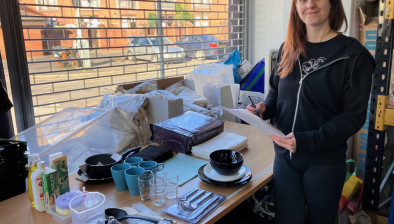Wyndford flats ‘not fit for purpose’, architect’s report finds

Michael Jarvis from MAST Architects
A new report by an architectural firm into the regeneration of Wyndford has confirmed the demolition of four multi-storeys is the best option.
The study by MAST Architects explored retrofitting the 200 bedsits and 400 one-bedroom homes within the four multi-storeys in the Glasgow community.
The report found the blocks are “not fit for purpose” and cannot be made larger to meet current minimum floor space standards.
MAST Architects’ report is the latest study to be carried out into plans by Wheatley Homes Glasgow to demolish the four blocks and build around 255 larger family homes for social rent and 45 for mid-market rent as part of a £73 million regeneration.
A report last month by respected environmental and sustainability architect, Dr Richard Atkins, stated “there is little or no basis on which to argue for the retention of the existing blocks on the grounds of either energy efficiency or CO2(e) emissions”.
The original review of the Wyndford blocks by structural engineers A J Balfour over two years ago also concluded the buildings could not be safely reconfigured. The A J Balfour report stated: “The practicalities of cutting through thick concrete walls will be difficult and significantly disruptive, thus compromising the structural integrity and stability of the blocks. Consequently, the works are not feasible from a structural standpoint.”
Wheatley Homes Glasgow tenant chair Bernadette Hewitt said: “All three reports, by highly-respected leaders in their field, confirm conclusively that demolition of the four blocks and the £73m regeneration of Wyndford, including the building of 300 fantastic, new, super energy-efficient affordable homes, is the best option for both the community and the environment.
“A small group of activists with alternative agendas may not agree, but the vast majority of tenants are right behind the plans.”
Michael Jarvis from MAST Architects is a past president of the Glasgow Institute of Architects (GIA). He has 28 years’ experience in delivering sustainable housing projects and previously sat on technical, energy and housing steering groups for the GIA. He is currently the head of certification for The Royal Incorporation of Architects Scotland (RIAS), Certification of Design (Section 6 – Energy) Scheme.
Michael led the latest study looking into retrofitting the four blocks. He said: “This is about creating buildings and living standards which give tenants a better quality of life. These blocks are simply not fit for purpose and provide unacceptable living standards in the modern age.”
The Glasgow Standard sets out minimum requirements for all new-build housing funded through Glasgow City Council’s Affordable Housing Supply Programme. It outlines the standards and specifications the Council requires housing associations and/or private developers to achieve in Glasgow.
Michael added: “Retaining and retrofitting the bedsits and one-bedroom flats would not meet the minimum internal space standards set out by the Glasgow Standard.
“Although the Glasgow Standard is not typically retrospectively applied to existing buildings, if a significant investment were to be made retrofitting these blocks, these standards should be met as closely as possible to ensure the retrofitted building provided a high quality of space for tenants.
“The space standards of the apartments are very poor, with the bedsit apartments only 38m². The one-bedroom apartments are 47m², which is approximately 5-8m² smaller than the average new-build one-bedroom apartment.
“Living space is also very limited with the combined living and kitchen area of the one-bedroom apartment 4m² smaller than the minimum required.”
Campaigners have called for the four tower blocks in Wyndford to be retrofitted, citing the example of Cedar Court in the Woodside area of Glasgow.
However, Michael believes it is wrong to make such a comparison. He added: “You need to compare apples with apples, which these two are not. Cedar Court is made up of family-style housing called maisonettes. They are all two-bedroom properties, with their own private balcony, compared to the cramped one-bedroom and sub-standard studio properties at Wyndford. The properties at Cedar Court were not structurally modified and the units are far more generous and spacious to meet the space standards.
“Each multi-storey block has to be reviewed on a case-by-case basis and, in this case, these two multi-storey blocks are poles apart.”
The report by MAST Architects also highlighted:
- poor levels of natural lighting, with the windows in the bedsit apartments overshadowed by the balconies above;
- poor wifi and mobile phone connection caused by the thick reinforced concrete walls;
- and a lack of privacy as balconies are shared by the three apartments on each level.
Historic Environment Scotland last month rejected a proposal by campaigners for the four tower blocks to be given a building preservation order, stating “the buildings do not meet the criteria of special architectural or historic interest required for listing’ and ‘they are not early, unusual or rare examples of their building type”.









